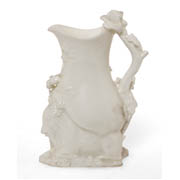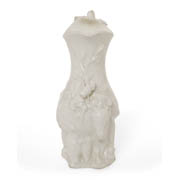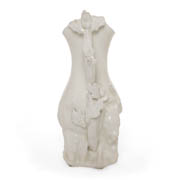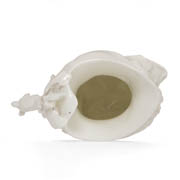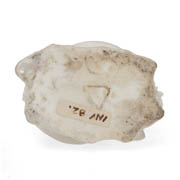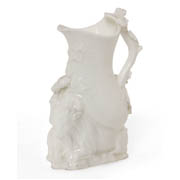Details
- Object type
jug
- Artist/Maker
Chelsea Porcelain Works maker
- Place Associated
England, Chelsea (place of manufacture)
- Date
circa 1745
- Materials
soft-paste porcelain
- Dimensions
overall: 108 mm 105 g
- Description
-
This eighteenth-century soft-paste porcelain cream jug, known as a 'goat-and-bee' jug, has moulded decoration in relief, with handle simulating a branch with oak leaves and flowering branches. The lower section is finely moulded in relief with two goats seated nose to tail, facing in opposite directions. Below the spot, there is an applied bee resting on a flowering plant.
This ‘goat-and-bee’ jug was made by the Chelsea Porcelain Factory and designed by the factory’s found Nicholas Sprimont (1716-1771), a Huguenot silversmith. Sprimont had previously used the motif of two goats on his silver objects. Sprimont used two goats parallel but facing in opposite directions on a silver centrepiece dating from 1747, created for the Ashburnham family (currently held in the collection of the V&A Museum, Ashburnham Centrepiece, accession number M46-1971).
The jug demonstrates Rococo style, which was popular in the 1700s. It used asymmetrical scrolling patterns and serpentine lines to create whimsical shapes. Rococo artworks often showed allegorical themes or classical myths. The motif of two goats may be based on a story from Greek mythology: a goat nourished the king of the Greek gods, Zeus, with milk when he was an infant. It is possible that the curvy shape of the goat and bee jug is influenced by a woodcut print made by Italian painter Domenico Campagnola (c.1500-1564) called Two Goats at the Foot of a Tree (Fig. 2), which depicts a curved tree trunk. Sprimont had collection of pictures and drawings and it is possible that he had a copy of Campagnola’s print.
Chelsea porcelain products were costly, luxury items in 1700s. ‘Goat-and-bee jugs’ were popular collectables, used to pour milk into popular hot beverages such as tea. In wealthy households, tea and coffee were generally served by the lady of the house in the afternoon and after supper in the drawing room. Some examples of ‘goat-and-bee’ jugs were decorated with colours, while many were left white or cream. Other porcelain factories, like Vauxhall, created their own jugs modelled after the popular Chelsea ‘goat-and-bee’ jug.
The base of this ‘goat-and-bee’ jug is incised with a triangle mark, to distinguish this piece as genuine Chelsea porcelain. During the early period of 1743-1749, Chelsea Porcelain Factor products bore and incised triangle mark. Later, the factory’s mark was changed to a red anchor (1752-1756), and then to a gold anchor (1756-1769).
Provenance: William Burrell
- Credit Line/Donor
Gifted by Sir William and Lady Burrell to the City of Glasgow, 1944
- Collection
Burrell Collection: English Pottery [Stoneware, Porcelain]
- ID Number
39.82
- Location
Burrell Collection Central Galleries

